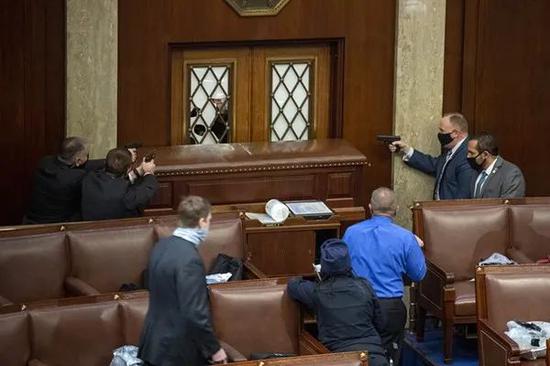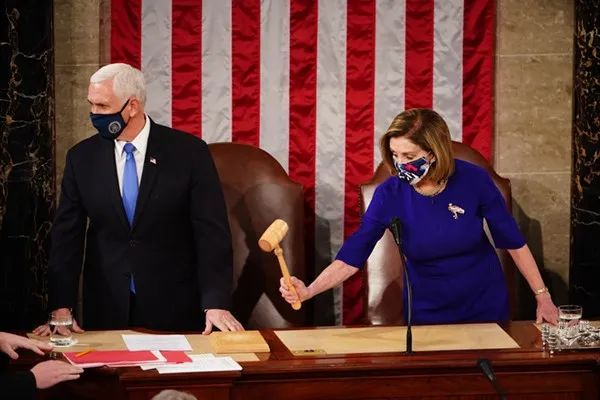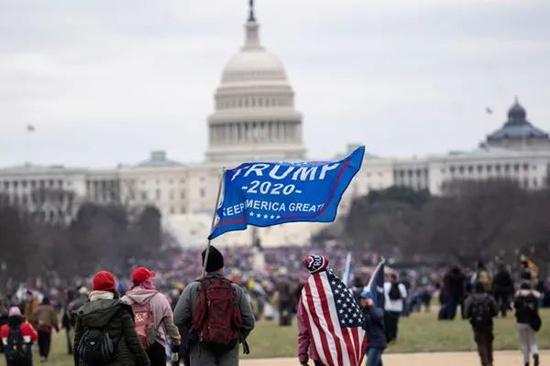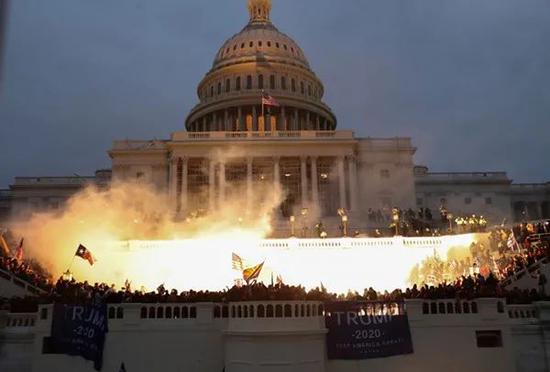On the afternoon of the 6th, a rare scene in the history of American politics occurred on Capitol Hill in Washington: the Senate and the House of Representatives held a joint meeting in accordance with the constitutional provisions to officially count the votes of certified voters under the chairmanship of Vice President Pence in his capacity as President of the Senate.
This presidential election final procedure used to be a “walk-through”, but this year it was forcibly attacked by President Trump’s supporters and forced to be interrupted for several hours. U.S. police said on the 6th that the violent impact of some demonstrators on the Capitol that day had killed four people.
Hundreds of demonstrators who refused to accept the election results pushed down roadblocks, crossed the cordon, climbed the Capitol, broke windows, smashed doors and fought with the police, and quickly spread all over the world.
Republican leader McConnell of the Senate called it “a failed rebellion”. For the first time in modern American history, the transfer of power “devolved into a physical confrontation in the corridor of power in Washington” and “shocked the image of thousands of Americans unwilling to accept the election results and tried to interrupt the transfer of power.
Shocked, worried that “violence, chaos and destruction have shaken the core of American democracy”, and the “political system of the United States may have been permanently damaged”.
Riots
Since the 5th, tens of thousands of right-wing voters in the United States have rushed to Washington from all states under the call of President Trump to hold a “Save America” demonstration outside the White House on the 6th.
Many of them wear camouflage clothes, red hats, and wave various flags. Many of them don’t wear masks. Speaking at the rally, Trump refused to admit defeat, claiming that the election was “stealed” and “rigged”, that he would “never give up, never admit defeat”, and denounced “too many weak Republicans” who did not support him.
He urged demonstrators to march to the Capitol, cheering from time to time in the crowd.

The joint session of the Senate and the House of Representatives began at 1:00 p.m. Eastern time, but an hour later, hundreds of demonstrators stormed the Capitol and clashed with the police. Congress was blocked.
The Electoral College’s counting and authentication process was suspended. Police issued an “internal security threat” warning requiring people to enter the office and stay away from doors and windows. Find shelter and keep silent.
In the Rotunda of Congress, members hid on the floor and prepared to use gas masks to avoid being affected by the police launching tear gas to disperse the demonstrators. Pence was escorted out of the emergency, and the Pentagon urgently mobilized the National Guard to reinforce.
On the same day, an explosive device was found in the Republican National Committee building in Washington, and Democratic National Committee personnel were evacuated; curfews were declared in Arlington, Virginia, the site of the Pentagon, in Washington, D.C. and the Pentagon.
President-elect Biden made a televised speech calling on Trump to defend the Constitution and stand up to “end the siege of Congress.” Trump, on the other hand, posted a short video on social media, reiterated his claim that the election was stolen, calling on the demonstrators to “go home”, and saying, “We love you, you are special.” That night, social media companies tweeted to freeze Trump accounts for 12 hours.
McConnell called the 6th Congressional Certified Electoral College vote the most important time since he entered the Senate, publicly saying: “If the election results are overturned, American electoral politics will enter a death spiral.
We will never see the whole country accept the election results again. Every four years there is a struggle for power at all costs.”
Reason
At 8 p.m. on the 6th, after hours of chaos, Congress resumed counting the votes of the electoral college.
Due to the opposition of some Republican lawmakers to the election results in some states, the debate vote is expected to last for hours or more, but the result is no suspense – Biden won 306 in the 2020 U.S. election.
Winning the Electoral College by a vote of 232, he will be officially confirmed by Congress as the 46th President of the United States.

Nevertheless, according to public statements, at least 140 Republicans (about two-thirds of House Republicans) and at least 12 Republicans (nearly a quarter of Senate Republicans) are expected to support Trump’s efforts to overthrow the presidential election results, which is more than the United States. Many people expected it.
Nevertheless, at the 6th rally in Washington, Trump’s son Donald Trump Jr. still criticized congressional Republicans for not doing enough. “This rally should send them a message: this is no longer their Republican Party, this is Donald Trump’s Republican Party.”
Previously, about 60 election lawsuits initiated by Trump and his supporters were rejected or dropped due to lack of evidence, and states have officially held an electoral college vote to confirm Biden’s election.
Why are there so many Republicans still supporting Trump’s efforts to overthrow the election results?
Many analysts believe that this is not because they believe Trump’s statement or believe that there is a realistic possibility to reverse the election results, but to obtain “political dividends” and thus “inherit Trump voters” in the hope that Trump supporters “remember their battles in the next few years”.
Former Republican presidential candidate Romney, harassed by Trump supporters on his way to Washington, accused Republican lawmakers who echoed Trump’s challenge to the election results of “ambitishing the principle”.
The persistence of a large number of “Trump voters” is closely related to the polarized environment of bipartisan politics in the United States over the years.
Party disputes are getting whiter and whiter, and the social media echo wall is getting higher and higher, which has continuously strengthened the “information cocoon room”, and many politicians ignore the truth for their own interests. Media reports are often one-sided.
Mutual trust in American society is constantly weakened.
A large number of voters from the two parties choose the channels to receive information according to partisan positions, and their understanding of basic facts is very different. U.S. media generally expects that thousands of American voters may never believe in the election results.
Divide
Three major events that occurred or were happening in the United States on the 6th – the Capitol Hill riots, the debate and vote on the certification of the election results in Congress, and the runoff results of the Georgia Senate, set up a basic setting for Biden’s political stage in Washington two weeks later.

Analysts here believe that the Capitol Hill riots show how difficult it is for a large number of “Trump voters” to accept the results of the 2020 U.S. presidential election.
Although the pro-Trump Republicans did not accuse specific election fraud, they quoted Trump’s accusations, which would encourage some people to take the election results. “Deep distrust”.
Congress’ debate and vote around the certification of the election results actually force every Republican congressman to stand in the election dispute whether to support or oppose Trump, which is bound to exacerbate the serious division within the Republican Party.
Several U.S. media predicted on the 6th that Democrats would win the Georgia Senate runoff on the 5th, and 50 Democrats and 50 Republicans would split the Senate seats equally.
Once Kamala Harris became vice president on January 20, she would vote to break the deadlock and make the Democratic Party history in the United States.
Democratic Senator Chuck Schumer, the Senate majority party with the least advantage, will be the leader of the majority party. This will guarantee Biden’s important administrative and judicial appointments, but the fragile congressional advantage makes Biden need to face more demands and pressure from the right Republican and the Democratic left. Social division and weakening mutual trust pose a greater test for him to practice his commitment to unity.
At present, Trump has been accused of “inciting instability” for the Capitol Hill incident. Six days later, the political path to overthrow the presidential election results was basically “exhausted”.
In response to the results of two Georgia’s two federal runoffs, some Republicans criticized Trump’s allegations of election manipulation and lowered Georgia Republicans. Voter approval rating, which helps Democrats win.
With only two weeks left before the presidential inauguration, it is unpredictable what Trump will do next. Many American analysts believe that he will not stop, and even after Biden takes office, he will try his best to maintain his influence on Republican and Republican voters.
Many things that have happened in Washington over the years are often lamented by the media here.
On the 6th, Congress certified the election results. Many people thought that the 2020 presidential election would come to an end, but they did not expect a new peak of the division of the United States. However, on second thought, it is not surprising that to a large extent, this is the result of Washington’s political polarization.
The seeds of doubt have been sown. In response to the Capitol Hill incident, Biden called for “rebuilding a politics that solves problems and watch and helps each other, rather than inciting hatred and chaos”.
Perhaps this event will strengthen the desire of American society to seek compromise and consensus, but it also highlights the harsh reality Biden will face when he comes to power: not only has the United States been severely damaged by the epidemic and the recession, but will continue to be deeply torn apart by various ways and forces.
American politics is about to enter a new deep water.
As Ben Sheehan, an American political writer, said: The Capitol Hill incident shows that there is a lot of “reconstruction work” to be done in the United States.



